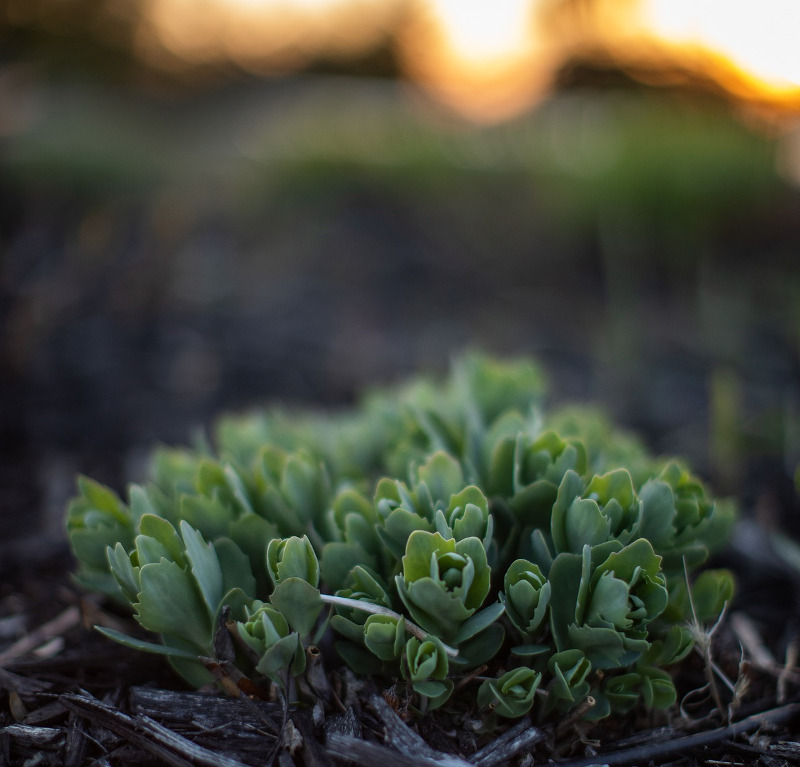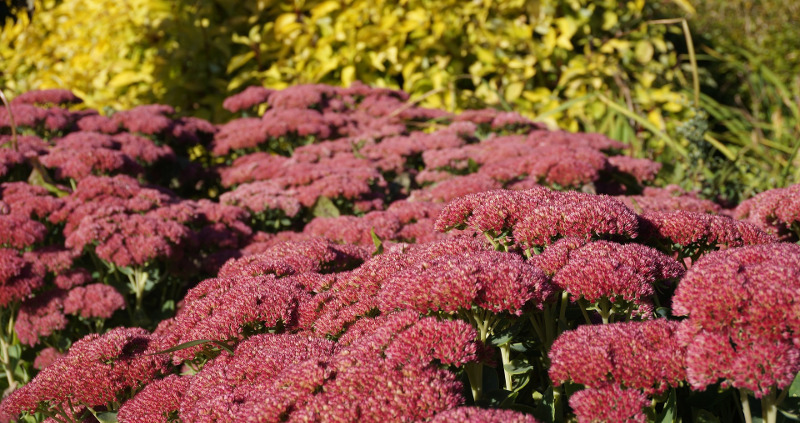Sedum, also referred to as Stonecrop, is a perennial succulent plant. This succulent has fleshy, water filled leaves which makes it heat tolerant and drought resistant. Hardy in zones 3-10, sedum needs very little care or attention. Sedum thrives in full sun and well drained soil. It is perfect when planted in a garden area that gets too much sun or too little water.
Low growing sedum spreads along the ground and grows a few inches high, while upright sedum grows in tall clumps producing a mass of tiny flowers. This versatile plant can be used for rock gardens, rock walls, as ground cover, for edging, or as a container plant.

What You Need To Plant Sedum
- Shovel
- Sharp spade or garden knife
- Compost or manure
- Well drained dry soil
- Area that gets full sun
Where to Plant Sedum
Sedum thrive in well drained, neutral to slightly alkaline pH soil. Heavy wet soil can easily cause root rot in the plant. Overly rich soil can cause leggy growth resulting in the plant becoming top heavy when in full bloom. Sedum is a good choice for sandy soil, raised beds, slopes, containers, or rooftop areas.

Do Sedum Like Sun or Shade?
Most sedum grows best in full sun. Five hours or more of full sun per day is recommended. Some varieties with pale green, yellow, and white foliage- such as our Rock 'N Grow® Lemonjade Stonecrop Sedum, need dapple sun to prevent sunburn. Sedum can tolerate afternoon shade; however, upright growing varieties can droop if they do not get enough sun.
Sedum Spacing
Sedum can be grouped into two categories, clumping and creeping. Creeping sedum spread a few feet across the ground. Clumping sedum can grow 1-3 feet tall. Depending on the variety and how quickly you want to fill your garden area, it is best to refer to the label on your plant.
A general rule is to space tall growing sedum 1 to 2 feet apart. Plant creeping sedums 6 to 12 inches apart. As sedums mature, its roots do not grow deep. They can be planted with other plants and near structures without becoming invasive.
Do Sedum Spread?
Clumping sedums do not spread as they will grow tall. Creeping sedum varieties are known to quickly spread across the ground, which actually helps to control weeds. The plant will self propagate from seed and from producing new cones at the base of mature plants. You can slow the spread by pinching off new growth at the base of the plant. This will create a compact stem and thicker growth.
Steps To Plant Sedum
Sedum is one of the easiest perennials to plant. Shorter varieties will root themselves by sending out roots just by the stem touching the ground.
With taller varieties, it is as simple as breaking off a stem and pushing it into the ground. The stem will root on it’s own after one season. Water thoroughly when planting, but very little after the plant is established. Sedums thrive with an organic compost versus chemical fertilizer. When transplanting a container plant, a few more steps are needed.
Step 1- Choose an area with well drained dry soil that gets full sun.
Step 2- Turn the soil 6-12 inches deep, removing debris.
Step 3- Mix organic matter into the soil. Keep soil area level.
Step 4- Dig a hole large enough to fit the root ball.
Step 5- Loosen the root ball by hand, separating the roots well.
Step 6- Place the root ball level with the surface soil. Fill with soil and pat down firmly.
Step 7- Thoroughly water and add a thin layer of mulch.

When to Plant Sedum
The best time to plant sedum is in the early spring after the threat of frost is past. Be sure to plant before the heat of summer sets in. Sedum will grow about an inch a month and bloom in the fall. The plant will continue to look attractive through winter. You can transplant sedum in the fall or plant cuttings from sedum anytime through the growing season.
Transplanting Sedum
Sedum (Stonecrop) is one of the easiest succulents to care for as well as transplant. It has a shallow root system so stems can be effortlessly pulled up and moved to a new area or potted in a container. Transplanting sedum can be done anytime during the growing season.
Clumping sedum can grow too much causing the plant to flop over. This makes a large hole or “dead” area in the center of the plant. This is a sign that the plant needs to be divided. Dig the entire plant out of the ground. Using a garden knife or spade, cut sections of the plant and move to another location. Follow the directions of “How to plant Sedum.”

Creeping sedums are simple to propagate. Gently pull up some stems and shallowly stick them in the new soil area or container. The plant can also be laid on top of the soil to develop a new root system.
 |
Author Chris Link - Published 01-27-2021 |
